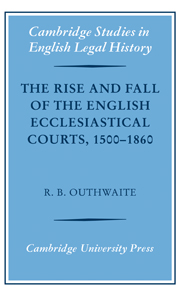Book contents
- Frontmatter
- Contents
- Foreword by R. H. Helmholz
- Preface
- Table of parliamentary statutes
- List of abbreviations
- 1 The ecclesiastical courts: structures and procedures
- 2 The business of the courts, 1500–1640
- 3 Tithe causes
- 4 Wills and testamentary causes
- 5 Defamation suits
- 6 Marital suits and marriage licences
- 7 Office causes
- 8 The roots of expansion and critical voices
- 9 Charting decline, 1640–1830
- 10 Explaining decline
- 11 The bills of 1733–1734
- 12 Snips and repairs: small steps to reform, 1753–1813
- 13 Royal commissions and early fruits, 1815–1832
- 14 Reform frustrated
- 15 Reforms thick and fast, 1854–1860
- Select bibliography
- Index
8 - The roots of expansion and critical voices
Published online by Cambridge University Press: 21 January 2010
- Frontmatter
- Contents
- Foreword by R. H. Helmholz
- Preface
- Table of parliamentary statutes
- List of abbreviations
- 1 The ecclesiastical courts: structures and procedures
- 2 The business of the courts, 1500–1640
- 3 Tithe causes
- 4 Wills and testamentary causes
- 5 Defamation suits
- 6 Marital suits and marriage licences
- 7 Office causes
- 8 The roots of expansion and critical voices
- 9 Charting decline, 1640–1830
- 10 Explaining decline
- 11 The bills of 1733–1734
- 12 Snips and repairs: small steps to reform, 1753–1813
- 13 Royal commissions and early fruits, 1815–1832
- 14 Reform frustrated
- 15 Reforms thick and fast, 1854–1860
- Select bibliography
- Index
Summary
The discussion in the previous chapters has revealed a number of important characteristics of the business of the ecclesiastical courts in the hundred years after the 1530s. One is that the instance side of their business, especially in the higher courts, was much more important than the office side. Litigation, in other words, was more important than prosecution. This is true in relation both to the numerical incidence of cases and to the profits that the courts and their officials derived from the system. Private litigation lasted longer than office prosecutions. It often spawned large quantities of paper and parchment, every piece of which had to be paid for by the parties engaged in the suit. It is abundantly clear, moreover, that the instance side was dominated by tithe, testamentary and defamation litigation. Without these three classes of action there would have been little instance business to discuss, because some formerly prominent classes, such as matrimonial litigation, had shrunk to insignificant proportions. But the rise in the business of the courts was not totally dependent on these three classes. Office prosecutions also expanded, albeit spasmodically, and apparitors and court scribes received some financial benefit from this, through the production and service of citations and absolutions. Chancellors and registrars, on the other hand, stumbled into an increasingly profitable trade in marriage licences, the sale of which, as we have seen, was burgeoning from the later sixteenth century onwards.
- Type
- Chapter
- Information
- Publisher: Cambridge University PressPrint publication year: 2007



